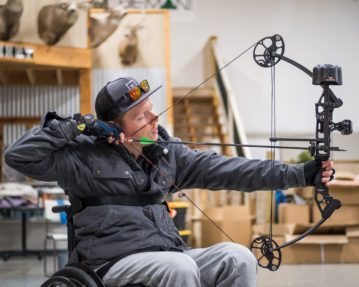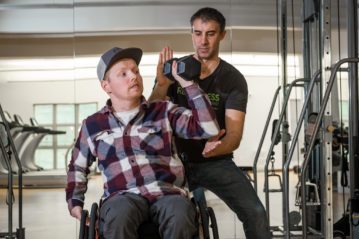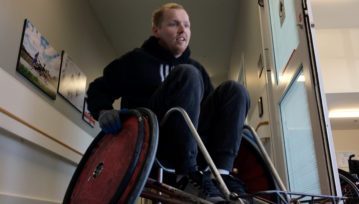It looks less like a wheelchair and more like the imagining of some brutal end-of-world steampunk fiction, all crisscrossing metal and scuffed aluminum. The wheels splay away from the seat of the chair at a 30-degree angle. The flat panels covering the wheel spokes display a history of combat, a history transcribed in scars and gouges and black streaks. From the footrest near the floor protrudes an ominous cage that looks indestructible despite its own signs of wear.
This is special kind of wheelchair. Though engineered for rugby, the true intent of its design keeps a laser focus on one, and only one, objective: survival.
Its occupant, Seth Wannamaker, is cut from the same veritable cloth. He’s a survivor. A workhorse. Someone who makes the most of every opportunity. On this day, during a frozen and snow-blanketed January, he arrived fifteen minutes early to put in extra reps and reap the benefits of extra practice.
Seth expertly maneuvers the rugby chair to the threshold where the hard flooring of QLI’s physical rehabilitation center meets carpet—the entrance of a long hallway. He rocks back and forth in his seat, poised to throw the wheels forward with the maximum possible force.
20 yards down the hall, his trainer—QLI adaptive sports coordinator Jack Mahaffey—waits with a stopwatch app open on a phone. In his off-hand he holds a folded page torn from a legal pad. On it, a list of sprint times recorded by Seth during past training sessions.
All but one of those times, the very fastest, has been scratched out.
—
Before arriving at QLI, doctors gave Seth Wannamaker a percentage. Ten percent.
“That was the chance I had to get anything, any movement, back.”
26 years old at the time of his injury, Seth clawed his way out from homelessness in his early twenties to earn union employment as an industrial painter in the Pacific Northwest. He made his living operating on large scale private and municipal projects, often spending upwards of twelve hours each day on suspended rigging to coat and refinish city bridges and massive cargo barges.
During work on an industrial site, Seth fell approximately ten feet from the top of a ladder. The fall shattered his C6 vertebra, knocking him unconscious and leaving him with no feeling below the neck.
Waking to the news of the injury and the grim projection for his future only kickstarted his defiance.
“I just kept thinking, ‘That can’t be right,’” Seth says. “I refused to let that be right.”
Four hours after receiving the news, he was moving his fingers on his own.
That burning determination powered him through six weeks of rehabilitation at an Oregon medical center. But when the time came to return home, Seth—still collared by a neck brace, still without much use of his arms or core muscles—sought out additional resources.
“I didn’t care what anyone said—I wasn’t ready to stop intensive therapy. I wanted to keep getting back what I could, and I knew that wasn’t going to happen by working one or two hours a day.”
In August, the pursuit of intensive rehabilitation brought him to QLI.
It didn’t take long for Seth’s team at QLI to recognize his overwhelmingly competitive spirit, something cultivated in his youth as the fourth-youngest of nine children. Even in down periods between clinical appointments, Seth challenged his therapists to board games and word games with the same tenacity he used to best his siblings growing up.
Seth’s competitive drive became the cornerstone of his rehabilitation program, appearing predominantly in the form of a wide arsenal of adaptive sports. Here, he could establish short, meaningful, concrete goals to chase in more traditional therapies.

“See, that’s a good thing,” Seth says in retrospect. “Because, you know, I’ve got two or three guys helping me shoot this arrow. I can say right there, okay, what steps do I need to take to do this alone?”
Wheelchair rugby training forced him to apply his upper body strength in exhausting 20-yard sprints and snaking obstacle courses. And QLI’s partnership with local business Joe’s Karting gave Seth the chance to get back to one of his favorite pre-injury passions despite his compromised physical abilities. In fact, new challenges on the race track offered uniquely powerful opportunities to regain his lost arm and grip strength.
He returned to therapists with a battery of goals. QLI’s clinical team responded with a dynamic rehabilitation curriculum that targeted the muscles and coordination he needed to exceed those goals.

To this day, Seth carries with him sheets of paper, sometimes even a notebook, always to keep a record of his progress. He scribbles the times of his rugby sprints in a list, or keeps the printout of his fastest go-karting lap nearby.
He considers these measurements the way a statistician would hard data. Evidence that what he’s doing in therapy creates tangible benefit. And if he goes a day without eclipsing his personal best—truly, a rare occurrence on his quest toward recovery—he doubles his effort.
Months ago, lifting his arms in front of his body would have toppled him over. Physically, he wouldn’t have been able to right himself from such a position, essentially folded stomach-first onto his knees, without help. Today, he holds steady and can keep himself from falling forward. It isn’t easy, but he can do it.
“That’s the thing about loss,” he says. “Even in loss, there’s gain. Everyone hates to lose. But there’s always a way to come back. The idea is to prove everyone’s doubts—even your own—wrong.”
—
Jack Mahaffey, stopwatch app in hand, shouts down to Seth from the far end of the hall.
“Three, two, one. Go!”
Seth heaves forward, throwing all his weight into these crucial first pushes. The chair moves at first with the lethargy of an animal waking from slumber. Stationary inertia fighting against Seth’s willpower.
Within moments, a span of time perhaps smaller than a full second, Seth’s posture changes. He sits upright. The movement of his hands grows finer, more calculated. No longer is he reaching down to the front of the wheel in an effort to generate force. As the chair gains forward momentum, subtle flicks of his hands at the top of the wheel add speed.
Seth’s sprints earlier in the training session were wild and swerving. He’d lost time fighting the chair in an effort to travel in a straight line. But this run—this run is true. There’s no combat. The chair offers no resistance. Seth is in full control.
He careens past Jack—who, leaning against the wall, marks the invisible finish line for the 20-yard dash. Jack gives out a loud shout and Seth, after coming to a full stop, is all smiles.
The time on the stopwatch?
5.64 seconds. Seth’s new personal best. Good enough to scratch the previous record from the list. After a fistbump and some celebration, it’s even good enough to end the day on. Seth looks at the list and the trail of records he’s set and promptly broken. They’re stepping stones to a larger purpose.
With a grin he says: “Let’s find a way to beat five-point-six.”
Categories: Client Story, Spinal Cord Injury

